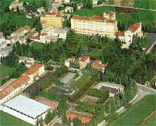 We were hopelessly obvious tourists, my mother and I. We sported unintentionally matching black fleece jackets, bags decidedly not made of leather, and confused expressions as we stopped at every corner to consult a city map.
We were hopelessly obvious tourists, my mother and I. We sported unintentionally matching black fleece jackets, bags decidedly not made of leather, and confused expressions as we stopped at every corner to consult a city map.But I was sure the Italians who walked past us and made a concerted effort to ignore our Americanness must understand our befuddlement. Their hometown of Verona, they must know, was a distracting place. For every sight we intended to visit, there was another equally interesting sight not marked on our maps that we stumbled upon and consequently forgot where we'd been headed in the first place.
This time, we were on our way to the Roman theater across the river from Verona's historical center. The city dropped us off two blocks from the ruins along a busy traffic artery. Which direction should we go? We pulled out the map once more. Then it happened again. Verona's distracting nature reared its too-beautiful head in the form of a narrow column of stone steps lined with sherbet ice cream apartment buildings. The engraved stone street sign on the wall, which read "Scalone San Pietro," begged us to climb the stairs to the top, where we knew the hill palace of Castel San Pietro stood.
With thoughts of Roman ruins gone from our minds, we climbed the stairs. It might have been the red of the first apartment building on my left, a color that reminded me of the Early Girl tomatoes that spilled over the sides of the planter box in the backyard one summer, that pulled me in. Or it could have been the quaintness of the basket-adorned bikes strategically locked against the ground-floor windows covered by iron bars. The paint on Number 7's facade was a splotchy salmon shade, the kind of color foreigners try to duplicate with sponges when they want the Tuscan look but that can only truly be achieved by the erosions of time. A grape vine snaked its way in and out of the iron-bar balcony, and I wondered why there weren't crowds of people gathered here, because surely this was the real balcony on which Juliet called for her Romeo. As far as I was concerned, this house, with its gently creeping greenery framing the wooden doorway, was the real Capulet family home.
In two more flights of steps, an iron gate stood open and a sign vaguely mentioned restoration. We curiously walked through and found ourselves in what
 looked like the Irish countryside. A deep thicket of grass stretched out to the base of a brick wall at the edge of the hill. Crudely hewn prisms of stone, placed all around the grass, served as benches. No one else was there, nor had anyone left evidence of having visited recently, adding to the park's austerity. Yet somehow the blank expanse of grass and stone was inviting, and I felt an urge to sit down with some panini and wine and gaze out at the mist. For even on this gray day, the city's entire expanse was visible from here. Past the River Adige, red spires and domes stuck out of the tile-cielinged maze and mopeds the size of ants scooted along the bridges. On a hill opposite the park, on the outskirts of the city, sat a massive Palladian-style columned creation above dots of houses.
looked like the Irish countryside. A deep thicket of grass stretched out to the base of a brick wall at the edge of the hill. Crudely hewn prisms of stone, placed all around the grass, served as benches. No one else was there, nor had anyone left evidence of having visited recently, adding to the park's austerity. Yet somehow the blank expanse of grass and stone was inviting, and I felt an urge to sit down with some panini and wine and gaze out at the mist. For even on this gray day, the city's entire expanse was visible from here. Past the River Adige, red spires and domes stuck out of the tile-cielinged maze and mopeds the size of ants scooted along the bridges. On a hill opposite the park, on the outskirts of the city, sat a massive Palladian-style columned creation above dots of houses.Why was no one here, I thought? Could there be a better view of Verona anywhere else in the city? Shouldn't Rick Steves let people know about this?
Perhaps, for all our fashion faux pas and touristy tendencies, my mother and I had the capacity to be trendsetters.

No comments:
Post a Comment